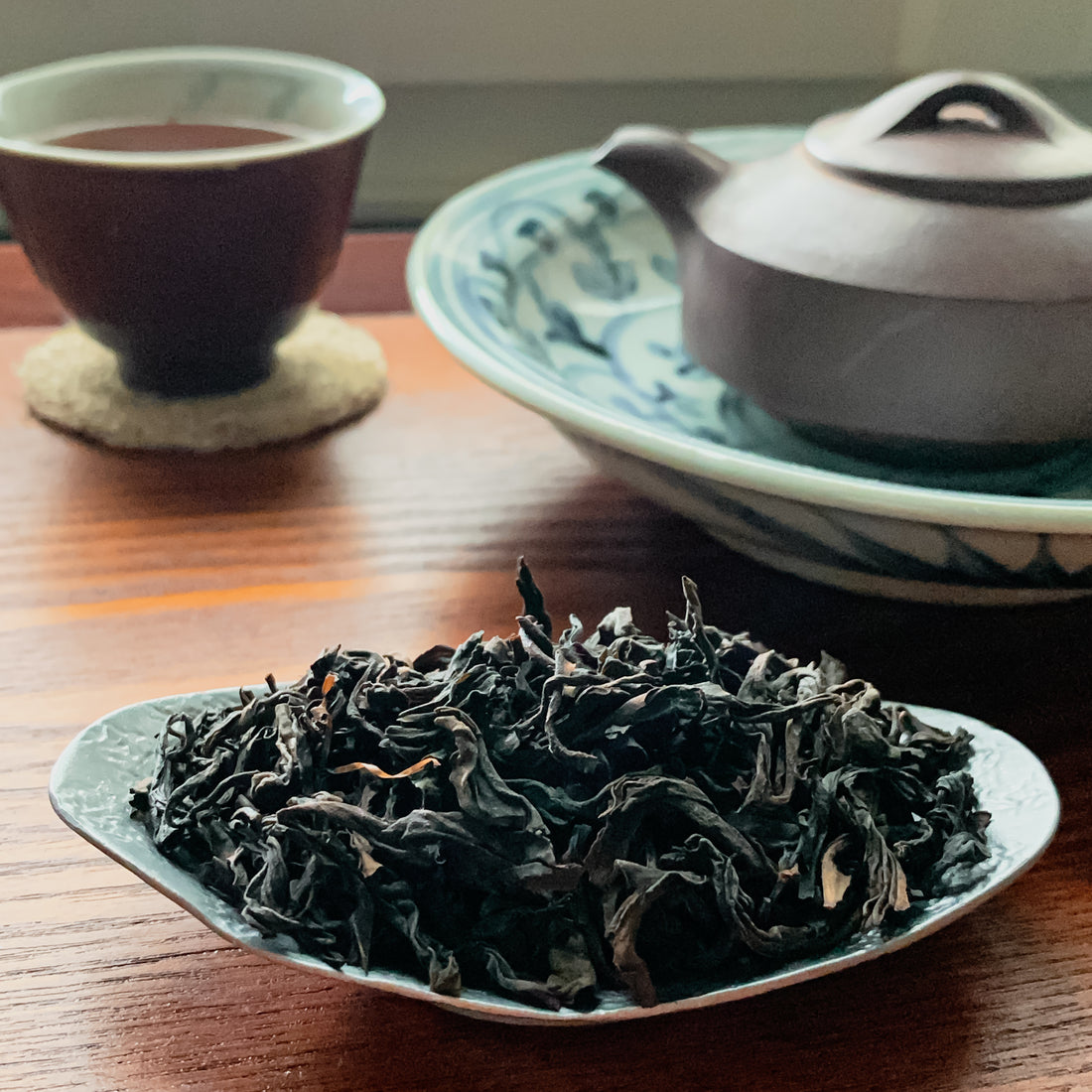2014 Long Juan traditional charcoal roasted Tie Guan Yin

When looking at the dry tea leaves of this 2014 Tie Guan Yin, I can see all the marks of the very traditional process. The heavy shaking (yao qing) and deep fermentation has produced leaves that resemble the long strips of Min Bei (northern Fujian) oolong rather than the tighter, pellet-like shape of Anxi oolong. After initial drying and sorting, the tea underwent two rounds of charcoal roasting to allow the tea to age without having to re-roast it. Once the roasting had reached the desired level, part of it was sold while the other part was set aside for further aging. Unfortunately, during this period other teas like the Wuyi oolongs or puerh tea, and especially puerh, captured all the light and the market for Anxi oolong became quite “sluggish”. Consequently, this batch of Tie Guan Yin, sealed and set aside and then “forgotten", until now.
The dry tea releases a slight acidity reminiscent of a blend of dried cranberries and apricots and is complemented by deeper notes of dry herbal scents, creating a moderately warm initial impression. As usual, I am tasting the tea using the gongfu method using 8 grams of tea leaves but no porcelain. An aged oolong requires a tea vessel that can breathe and interact with the tea in my opinion. And so, I am using a well-raised 130ml Pin Zi Ni teapot that only saw Anxi oolong tea since it had been in my hands. Like for any tea, the first step is rinsing it. After a quick rinse with boiling water, the tea leaves start to release their aroma. The herbal scent becomes deeper and has a layer of cereal husk, one that we know as sticky rice paper in China which is used to wrap traditional candies. As the tea leaves cool down, they emit a scent reminiscent of bread but retain a lingering sweet and sour aroma of dried fruits, resembling salted plums and starfruit found in East Asia.
 For the first brew, I opted for a 5 second infusion. The aroma of the tea soup is subtly restrained, with a neutral scent reminiscent of a blend of dried plums and roasted barley that provide a sense of comfort and relaxation. In mouth, the tea liquor is exceptionally smooth and mellow, with a profound, textured sensation that glides over the palate.The tea soup has a distinct fruity acidity, typical of aged Anxi oolong tea, that tickle the tip of the tongue and inside the cheeks and the the next step is a very pleasant refreshing sensation.
For the first brew, I opted for a 5 second infusion. The aroma of the tea soup is subtly restrained, with a neutral scent reminiscent of a blend of dried plums and roasted barley that provide a sense of comfort and relaxation. In mouth, the tea liquor is exceptionally smooth and mellow, with a profound, textured sensation that glides over the palate.The tea soup has a distinct fruity acidity, typical of aged Anxi oolong tea, that tickle the tip of the tongue and inside the cheeks and the the next step is a very pleasant refreshing sensation.
For the second brew, I gave the tea leaves a 8-second steep and while the tea soup remains similar but with a noticeable increase in refinement and subtle hints of ripe guava and custard apple. This tea has something taoistic about it to me. While it is very mellow and dense, it still has tannins that tingle the gums. The third and fourth brew were given 10 seconds and the tea showed remarkable stability with the presence of herbal characteristics complemented by a more distinct sweet guava notes. At that point, the tea leaves still have a slight evidence of charcoal roasting with pronounced aromas resembling dried scutellaria and Isatis root.
So far, the biggest impression this aged Tie Guan Yin gives me is a sense of ease and relaxation. If it was a picture, it would be one of Cantonese grandfathers sitting under a large tree on a hot and humid day playing chess or cards with their trustee thermoses and teapots filled with tea. Getting refreshed with a hot beverage during a hot day, there is another taoistic image. Another delightful aspect of this aged Tie Guan Yin tea is the absence of bitterness even after extended steeping. During my tea session, I was momentarily distracted and left boiling water in the teapot for nearly ten minutes before finally pouring out the tea. Despite the tea soup being highly concentrated with a significant caffeine content, it was rich yet devoid of any bitterness or astringency upon tasting. This encouraged me to intentionally steep another prolonged infusion for a final brew, confirming the tea's enduring and gentle character.

To finish this tasting session, I took a look at the tea leaves. They had unfurled to reveal a soft, uniform reddish-brown hue with glimpses of deep emerald green. Some speckles dot the surface of the leaves, colloquially known in southern or northern Fujian and Wuyi oolong teas as "toad skin," a common feature in traditionally crafted and roasted oolongs. The aroma from the leaves now begins to unveil a subtle floral fragrance, reminiscent of the delicate scent of white kapok flowers one can encounter while walking through the village during tea harvest season.

